THIS CRAZY DAY IN 1972: Get your own Daily News vending machine for free
Weekly Compilation May 22-28, 1972
To access all contents, click HERE.
Why do we run this separate item peeking into newspapers from 1972? Because 1972 is part of the ancient times when everybody read a paper. Everybody, everybody, everybody. Even kids. So Steve Bertolucci, the 10-year-old hero of the novel serialized at this Substack, read the paper too—sometimes just to have something to do. These are some of the stories he read. Follow THIS CRAZY DAY on Twitter, @RoselandChi1972.
Dying to know how to get your own Daily News vending machine? Last item. Read on!
May 22, 1972
Chicago Today
Nobody who reads Action Line, Chicago Today’s public service column, should be foolish enough to think you can put anything over on them. And yet.
Here, again, is a classic salty Action Line response to a classic bizarre Action Line query. As always I have to note: You’d never read this question or response in the Daily News’ Bee Line, and I love you Bee Line, but that’s just the way it is. Here goes:
“I was shot five times June 22, 1971 by two teen-agers in my garage.”
But wait—that’s not the problem.
“They used my own gun, which they stole from my home, and then they ransacked my house and stole money and jewelry. The two boys were found guilty and were sentenced. I’ve about recovered from the incident and have been trying to get my .38. revolver returned to me by the police. Whenever I go to the local station, however, I just get pushed around. The case is closed, and I can’t see why I can’t have my gun. It is registered with the city.” — C.E.
“ACTION LINE: Police have balked simply because you forgot a few details: You didn’t register the firearm until Sept. 9, 1971, when it was already in the possession of police. We’re also informed that your stepson plotted the shooting with three other teens to get even with you for a few beatings you administered to your wife and children. Because of your condition at the time, police didn’t charge you with failure to register firearms.”
May 22, 1972
In February, the big news was President Nixon’s historic trip to China.
In April, the big news was presidential aide (not even Secretary of State yet) Henry Kissinger’s secret 4-day trip to Moscow—while the Nixon administration claimed Kissinger was with the president at Camp David.
Now, the big news is Nixon’s historic trip to Russia—technically, the Soviet Union.
For both historic Nixon trips, the Daily News sent Peter Lisagor—the venerable reporter for whom the Chicago Headline Club’s annual awards are named.
In the Twilight Zone that is the Soviet Union, this is how Nixon’s presidential trip works: He was met at Moscow’s Vnukovo 2 Airport by President Nikolai Podgorny and Premier Alexei Kosygin, two men most readers have never heard of, rather than the person who actually rules the Soviet Union, which is Communist Party General Secretary Leonid Breshnev. Him, you’ve heard of.
Also per Soviet Twilight Zone protocol, the Russian public wasn’t told Nixon’s schedule—yet 100,000 comrades knew when and where to gather in order to line Nixon’s motorcade route from the airport to the city.
At the giant state banquet, Nixon met with Breshnev beforehand, and the Russians with no power made speeches later.
Nixon’s banquet speech focused on areas where America and the Soviets can cooperate. An arms control agreement, he said, “could begin to turn countries away from a wasteful and dangerous arms race, and towards more production for peace.”
He also talked about cooperation in space exploration, curing disease, improving the environment, and economics.
May 22, 1972
Chicago Daily News
May 22, 1972
Chicago Today
by John Hillyer
“DALLAS—In baseball terminology, ‘mullion’ is a wonderfully versatile word applied to anyone who, in his style of play or living, does things that meet with general disapproval,” writes John Hillyer.
“When he was a high school kid in Birmingham, Ala., Carlos May was a mullion.
“‘I used to throw my bat when I struck out, stuff like that,’ said the stocky left fielder of the White Sox. ‘I even used to cry after a game.’”
So May’s older brother Lee, now “the Houston Astros’ slugging first baseman,” had a talk with him. “He said there ain’t no sense in that,” May told Hillyer. It only makes things worse. It makes you think about it the next time at bat.”
“Thus control over his emotions is something that has been mastered by the fourth-year big leaguer Carlos is today, sometimes to the point where he might appear indifferent,” notes Hillyer.
“It is this cool that has prompted May’s manager, Chuck Tanner, to insist he’d rather see Carlos up there when a base hit is needed than anyone else on the club.
“And it’s why he accepts as just part of the ‘sweet’ that offsets the ‘bitter’ in life such feats as his ninth-inning, two-out, three-run homer yesterday in Chicago that catapulted the Sox past the California Angels, 9-8, and into first place in the American League West Division.”
Of course, there was a long game before the Carlos May’s home run heard ‘round Chicago.
Dick Allen “drilled an incredible home run off a television stand in front of the center field back wall in the second inning….Allen’s 440-foot homer, a three-run job, lifted his league-leading runs-batted-in total to 77.
“‘He’ll hit ‘em even harder than that before the season’s over,’ promised teammate Pat Kelly.”
May 22, 1972
Chicago Daily News
By Dennis Sodomka
David Monte graduated from IIT with a bachelor’s in civil engineering last week, then got shot in the head Sunday by robbers who invaded the rental shop where David and his brother Donald had worked for years to earn money for school.
“He had his whole life ahead of him,” said grief-stricken Mrs. Raymond Monte.
“One of two youths who walked into the store”—the Buzz-N-Brush Rental Co. in Roseland, 10317 S. Halsted— “pulled out a pistol, placing it next to David’s head. Without saying a word, the youth fired.”
“Police said one of the youths then turned to Donald and said, ‘If you don’t want the same, give us the money.’”
“‘I don’t understand it,’ said Raymond Monte, the boy’s father, a die sinker for a Blue Island firm. ‘He would have given the money—why did they have to shoot him?’”
David Monte was engaged to marry his girlfriend of five years, Kathy Hernandez, on August 26. His killers scooped $500 out of the cash register. That’s $3,375 in 2022 money.
“Murder warrants were issued Monday for David West, 19, of 1335 W. 109th St., and Charles J. Dees, 21, of 10819 S. Racine. Both were being sought after witnesses identified photographs of the two in police mug files”.
May 22, 1972
Chicago Today
by Jeff Lyon
Chicago Today continues David Monte’s sad story:
“An ill-timed phone call…in the tool rental shop where he and his brother had worked five years disconnected David Monte’s plans and his life,” writes Jeff Lyon.
“For the two bandits who yesterday coldly gunned down the 21-year-old as he spoke on the phone thought he was talking to police. David was merely talking to a customer of the Buzz-N-Brush Rental Co., however.”
Lyon learned this from the “deeply upset” father, Raymond Monte.
“An itchy finger is all I can figure,” Monte told Jeff Lyon. “In a way I guess that saved Donald, because they apparently wanted to get out of there as quickly as possible.”
The Montes have five other children.
May 22, 1972
Chicago Daily Defender
Last week, Alabama Gov. George Wallace was shot five times on May 15 by a would-be assassin as he campaigned for the Democratic presidential nomination. Wallace was notorious for opposing desegregation, proclaiming in his first gubernatorial inaugural address, “segregation now, segregation tomorrow, segregation forever.”
Although Wallace was obviously a very controversial politician among fellow Democrats, everyone but Ald. Anna Langford gave the press diplomatic and sorrowful comments. Per the Tribune, Langford said: “He is a violent man and when you live violently you die violently.”
The Defender’s Lucille Younger reported on May 17 that Langford’s office had been inundated with phone calls, “admonishing the 16th Ward Alderwoman’s outspoken reaction”. The Defender ran this as a front page story with the top, giant headline: “Ald. Langford hit for Wallace rap.”
This week, the Defender prints several reader letters on the topic all in this vein:
May 22, 1972
Chicago Today: Bruce Vilanch’s TV Report
Bruce Vilanch watched TV over the weekend, and noticed something which he writes about today, Monday:
“We all know that, with the exception of All in the Family and Sanford and Son, the folks we meet on television are generally comfortable folks, sometimes beset by money problems, but always spiffy and well pressed….We all know this.”
Example: The groundbreaking show “Julia,” which ran 1968-71 and “was about a stunning woman who happened to be black and a widow and a nurse”. “Julia,” writes Bruce, provoked “a great bellow” from “critics who felt the show was not accurately portraying the role of the black person in America. The bellow was answered with a mild roar from Diahann Carroll, the show’s star, who modestly pointed out the obvious—this is television, not real life.”
That hasn’t changed in 1972, writes Bruce, because people generally watch TV for “pure escape.”
“All the problems must be either very large [will the bomb explode before the 707 lands?] or very small [will Keith Partridge be able to convince Mom that a dune buggy is really a worthwhile investment?].
So, TV is “a steady diet of bulletins from some other world. The one you run into at all those Expos and World’s Fairs. I don’t know how it affects you, but after looking at a concentrated weekend of it, it puts me in this vaguely dislocated, but terribly philosophical frame of mind.”
AND BIG NEWS Bruce saves for last: MIKE DOUGLAS COMES TO CHICAGO!
Mike is going to broadcast from Chicago all week, interviewing among others Ann Landers, Joe Pepitone, Saul Alinsky, Irv Kupcinet, and Herman Kogan—veteran Chicago journalist and father of current veteran Chicago journalist Rick Kogan.
See April 3 for a rundown on Mike Douglas and his most famous guests of 1972—John Lennon and Yoko Ono.
May 22, 1972
Chicago Daily News: Crosstown!
By Robert Signer
About 1,500 people turned out for the anti-Crosstown Expressway march on the South Side according to the News’ Robert Signer, which sounds good until he writes that organizers predicted 10,000.
Democratic gubernatorial candidate Dan Walker, who literally walked across the state to win his nomination, walked with the crowd in 90-degree heat on 55th St. from Kostner to Laramie, the one-mile wide swath of land that would be bulldozed under for much of the 22-mile L-shaped Crosstown. Mayor Daley’s dream project, the Crosstown would run from the Kennedy-Edens junction to Midway and cost $1 billion.
“Ladies and gentlemen, no ifs, no ands, no buts, no hearings, no more studies. I am unalterably opposed to the Crosstown Expressway,” Walker told the cheering throngs.
Other pols who showed up to oppose the Crosstown included U.S. Rep. Roman Pucinski, who must have obtained a political dispensation from Mayor Daley because he’s running for U.S. senator against incumbent Republican Charles Percy, and independent Democrat Ald. William Singer (43rd).
“Symbolizing the plight of many homeowners was a 69-year-old man, Julius S. Kopielski of 4844 W. George, who carried a sign that read: ‘I worked a lifetime for my home. Don’t undo it in a day.’”
May 22, 1972
Chicago Today: Crosstown!
by Michael Hirsley
Hirsley more positively calls the anti-Crosstown crowd “several thousand” strong. They “voted unanimously at a rally yesterday to organize a citywide tax revolt if Gov. Ogilvie and Mayor Daley do not disband Crosstown Associates, planners of the 22-mile, billion-dollar route.”
“We are here for the same reasons as earlier Americans: to organize against taxation without representation,” Father Leonard Dubi, cochairman of the Anti-Crosstown Coalition and of Citizens Action Program (CAP), told the crowd gathered at 55th and Laramie. See Lois Wille’s profile of Father Dubi in the May 2 Daily News for more on the prominent activist priest.
Dubi set a June 25 deadline for stopping the Crosstown, and starting a campaign to stop paying taxes by Sept. 1.
“Every one of us should bring five more people to the rally June 25 at the Civic Center. We will find out their answer at that time. We are saying to King Richard in Chicago, King Richard in Springfield, and Prince Adlai in Washington, ‘Don’t tread on us.’”
Here, Father Dubi names the pols who did NOT attend the anti-Crosstown march, and who are either pushing the expressway (Daley) or not actually saying they’re against it (Gov. Richard Ogilvie, Sen. Charles Percy).
Some signs at the march call the Crosstown “Daley’s Ditch.”
Without actually saying it, Hirsley makes the point that the anti-Crosstown coalition isn’t composed solely of white ethnics from the Southwest Side:
“The Rev. Ed Redding of Operation PUSH and Mrs. Ura Matthews, a South Side homeowner in the expressway’s path, said the Crosstown is planned not only to destroy black people’s homes but to put their children in its fumes by building two schools above the expressway, which will be depressed below surface.”
If you’re a regular THIS CRAZY DAY reader, you’ll probably want to follow Mike Royko 50 Years Ago Today too.
May 23, 1972
Chicago Daily Defender
Too bad we don’t have film of these performances! Here’s a YouTube video instead.
May 23, 1972
Chicago Tribune editorial
Channel 11 televised the May 17 City Council, a first in Chicago history. The Trib notes “there were fewer thrills than on the Doris Day Show.”
For Younger Readers: Doris Day herself and certainly her awful sitcom are period synonyms for “boring.”
Even though the meeting was so boring, the Tribune writes approvingly that TV cameras improved the “decorum,” as if that’s a good thing, rather than asking, “But at what price?”
“In the pre-TV days, council meetings were often somewhat rambunctious affairs, with aldermen hurling abuse at each other and sometimes threatening to hurl other things. We recall one session which featured Ald. [now State Sen.] Charles Chew jumping up and down in front of Ald. John J. Hoellen and flapping his arms, and another in which the major order of business seemed to be making fun of Ald. Seymour Simon’s haircut, or lack of it.”
Seymour Simon used to be a favored Machine pol who was elevated to Cook County Board President, but he displeased Mayor Daley and was cast back down into the Council. Per the Tribune’s obituary of Simon, he crossed Daley’s righthand man, Ald. Tom Keane, then the second most powerful man in Chicago, “by refusing to order the rezoning of 186 acres in Northfield Township for use as a garbage dump at [Keane’s] request.” Simon is now a lowly independent Democrat who has to write to the Daily News public service column “Bee Line” to get pot holes filled in his ward’s alleys. (See January 19 here.) But don’t feel too badly for Ald. Simon—he’ll end up on the Illinois Supreme Court.
May 23, 1972
Chicago Daily Defender
by Tony Griggs
“Police obtained murder warrants yesterday for two men believed to be the killers of a white store clerk who was slain Sunday during a $500 hold-up of the Buzz ‘N’ Brush Rental Company, 10317 S. Halsted St.”
Witnesses outside who saw the two robbers leave the store identified them from police photos—David West, 19, of 1335 W. 109th St., and Charles J. Dees, 21, of 10819 S. Racine.
“It was the younger of the two stick-up men, 19-year-old West, witnesses said, who walked into the store and placed a gun to [David] Monte’s head. Police said West pulled the trigger without saying a word.”
“Police records revealed that although West had been arrested previously, he had never been convicted of anything. Dees, however, was placed under a one-year probation on Feb. 4, 1970, for possession of marijuana and unlawful use of a weapon.”
“Dees reportedly lived at the Racine address with his family, but when asked about his whereabouts, his mother said, ‘How do I know where a grown man is?’”
May 24, 1972
Chicago Today
At the end of most columns, Action Line includes a “Sound Off” where a reader expresses an opinion. On April 28, a reader was shocked while attending a showing of “The Godfather”: “I never thought I would see a day come when an actor would stand up at a dinner table, whip out a pistol, shoot two men in cold blood and have the people in the theater loudly applaud him. It was very frightening and very barbarian.”
Apparently, a reader named Judy Newman subsequently wrote in about the same experience, and now “Godson” comments on Judy Newman’s comment. People cannot get enough of “The Godfather” in 1972. Plus ca change!
May 24, 1972
Chicago Today: TV Report by Marvin Kitman
I have a confession to make: Bruce Vilanch is not the only Chicago Today writer for “TV Report.” Occasionally TV Report appears with a different byline. But I only have eyes for Bruce.
However, today Marvin Kitman covers something too important to pass up. Stay with me: Kitman begins on the general subject of TV reruns, which is actually rather interesting itself.
The first TV station ever, WNBT in New York, “signed on the air” on July 1, 1941, writes Kitman. We should note here for Younger Readers something that Kitman assumes his readers already know: That for the entire 20th century, nearly all original TV shows aired between fall and spring, not counting talk shows like “The Tonight Show” and soap operas. During the summer, in a show’s regular time slot, you saw a rerun from the previous season.
But reruns didn’t begin immediately in TV’s infancy. TV shows were originally done live and often not recorded at all. The few recordings were done as kinescopes, which are lousy quality and were not practical for reruns.
Plus: “Advertisers weren’t interested in sponsoring repeats during the summer because the number of [TV] sets in use fell drastically. Before air conditioning, people couldn’t stand the heat in the TV den and wanted to get out.”
Even after window air conditioners became somewhat widely used, there was an issue: “Before everybody started bringing 220-amp lines into their houses, they had to choose between air conditioning and TV,” Kitman quotes Paul Klein, former NBC vice president for audience measurement and research. “If one put both on at the same time, the picture used to get smaller. Remember?” Or, he should have added, the house would blow a fuse.
By 1972, enough people have at least one window air conditioner that summer reruns are a TV staple. The term “summer rerun” is synonymous with “boring” at this time. So, boring = “Doris Day” = “rerun.” What about a Doris Day rerun? Now you’re heading into Twilight Zone territory.
Now, ABC sports “publicity genius-in-residence” Beano Cook has a new idea: “rerunning whole evenings of one show. As a test he would start with an All-Columbo Night, because of the large numbers of viewers who cannot get enough of Peter Falk.”
Paul Klein explains that you have to give people a reason to re-watch, and now he gets at something that many of us may think was never realized before “Talking Dead” spawned the craze of analyzing shows: “Then you have to stimulate discussion about the details of each episode. That’s why the ‘Casablanca’ thing going on today is so wonderful. Once you get people talking about the details of TV shows, the more repeats the better.”
Note: Apparently, there is a current craze for “Casablanca” that has not been mentioned in the papers. That might help explain the genesis of the current Woody Allen movie playing in theaters right now, “Play It Again, Sam.”
“One suggestion is adapting the atmosphere of film festivals,” writes Kitman. “Instead of an Orson Welles or an Andrew Sarris discussing what Lt. Columbo meant when he stood in the doorway, scratched his head and asked, ‘Say, do you have a match?’, there should be a panel composed of TV’s great detectives like Peter Gunn (Craig Stevens), Michael Shayne (David Janseen), Markham (Ray Milland) and Phillip Marlowe (Philip Carey). I can think of a lot of mysteries about my favorite detective character the panel could clear up:
“Is it true that Columbo’s first name is ‘Lt.’?
“Is he really married, or is he only using those references to his wife to fool the suspects into thinking that he’s a regular fellow?
“Where does he buy his cigars?
“Who is his tailor?”
May 24, 1972
Two robbers hijacked an Illinois Bell Telephone truck, tying and gagging the driver, then drove it to the Wittgren & Co. jewelry store at 8649 S. Cottage Grove on Tuesday morning.
There, one of them put on the repairman’s tool belt and apparently thought he was cutting the phone line but instead cut the Wells Fargo alarm wire, setting it off. The store was closed at the time.
Two squad cars arrived by 9:55 AM. Patrolman Robert Gallowitch drove his car around the back while patrolman Richard McGrath checked the front on foot.
“All of a sudden I heard firing,” McGrath told the Daily News’ Barry Felcher and John Linstead. McGrath ran through a gangway between the jewelry store and a service station next door in time to see Gallowitch firing at the Illinois Bell truck.
“McGrath said the man at the wheel of the truck…attempted to escape in the truck, but Gallowitch’s squad car was blocking the way. ‘I ain’t got a gun. Don’t shoot,’ (the driver) reportedly said.’…McGrath said that after the firing ended, Gallowitch told him, ‘I think I’ve been shot.’”
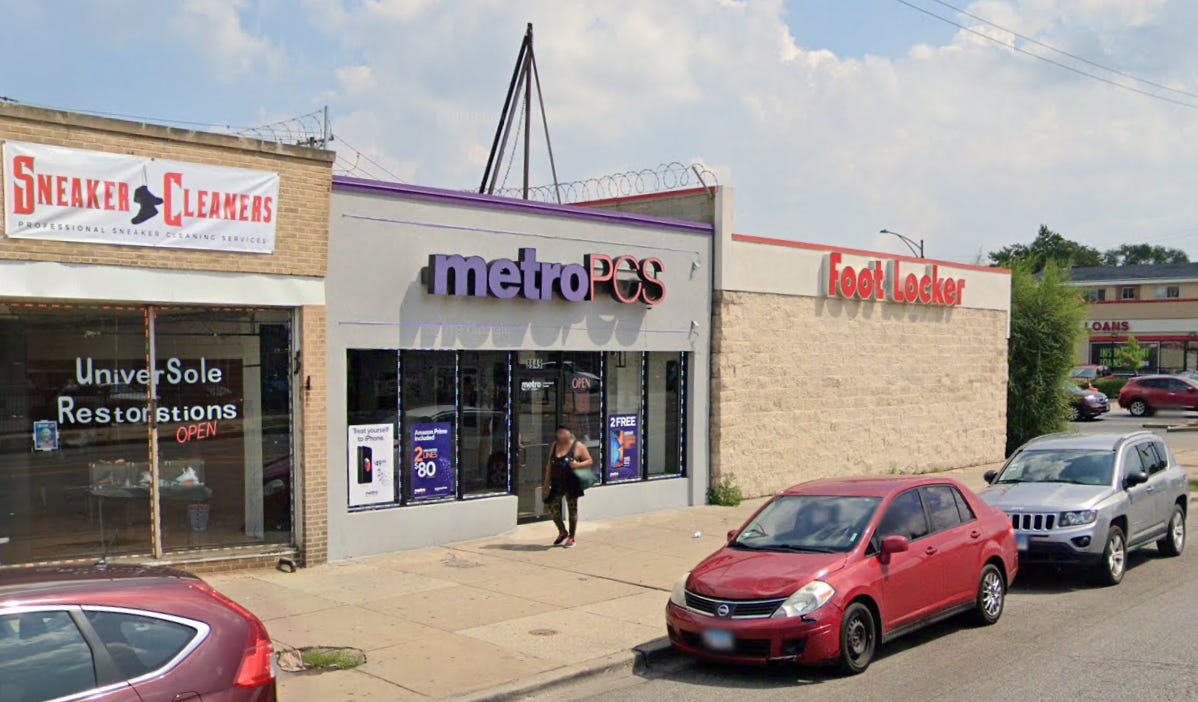
Police found a Saturday Night Special in the Illinois Bell truck, along with the kidnapped driver.
Surgeons at Jackson Park Hospital worked on Gallowitch, 30, for five hours, but he suffered multiple heart attacks during surgery. The driver and suspected gunman, Frederick Lancaster, 22, of either 2951 S. King or 7805 S. Phillips, was shot in the arm and leg by Gallowitch during the gun battle. He was also treated at Jackson Park Hospital. Two other robbers escaped.
Gallowitch graduated from Washington High School on the East Side and served in the army before graduating from the Police Academy less than a year earlier, in July 1971. He and his wife, Joan, lived with their two small children on the East Side at 11323 S. Avenue O.
Joan previously worked as a registered nurse at Jackson Park Hospital, where she waited during her husband’s surgery before finding out he didn’t make it.
May 24, 1972
Chicago Today
By Jeff Lyon
U.S. Rep. Ralph Metcalfe was a loyal Democratic Machine politician until suddenly he wasn’t. On April 24, Metcalfe officially broke with Mayor Daley over the issue of police brutality in the Black community.
In today’s article, Jeff Lyon gives us rousing quotes from Metcalfe both in a speech, and in an interview afterwards. Skip this background if you don’t need it.
BACKGROUND: Metcalfe and 15 other Black leaders met with Police Supt. James Conlisk in April and presented him with a six-point plan that includes terminating a Special Operations Group, establishing a Citizens Board in each police district, appointing Blacks to policy-making positions in the police department, recruiting more Black cops, promoting more Black cops, and doing all of it by May 31, 1972.
If not, said Metcalfe, “it is incumbent upon us then to go back to the community and set up techniques of survival for ourselves—and this, we are prepared to do.”
The following week, Metcalfe and Daley held dueling meetings to discuss police brutality. I’ve yet to see a paper specifically state which meeting was scheduled first. Metcalfe sent a telegram inviting Daley to his meeting, held on May 2 at Liberty Baptist Church, 4849 S. King Drive. Daley held his meeting on May 3 in the City Council chambers and invited hundreds of people, but somehow forgot to invite Metcalfe in his first giant round of invites. Metcalfe and most Black leaders boycotted Daley’s meeting.
During Mayor Daley’s police brutality meeting, Daley made a fiery speech defending the police. Supt. Conlisk presented his own six-point plan to fix the Chicago police department—which is not, of course, a carbon copy of Rep. Metcalfe’s six-point plan.
Metcalfe has brought an array of Black organizations and leaders together into the Concerned Citizens for Police Reforms. They demand that Mayor Daley meet with them in the Black community. Meanwhile, Supt. Conlisk is currently doing a tour of public meetings in police districts across the city, where he is mainly getting his ass handed to him by outraged audiences.
On May 23, Rep. Metcalfe spoke at a joint meeting of the Afro-American Patrolman’s League and the Guardians, a group that includes current and former Black police officers. The groups met at the Parkway Ballroom, 45th and King Drive.
From Metcalfe’s speech:
“It’s rewarding to be alive today, and it is a good feeling to be black and feel some sense of freedom, something we have been denied all of our lives.
“We are going to stay united this time. No Urban League one way, NAACP the other. And we are going for the jugular vein. We won’t be placated this time. We want to walk with dignity.
“No more being called downtown and being told ‘Look at all we’ve done for you.’ We want safe streets, safe for our women and men, just like everyone else, and we will get them.
“We no longer will be hoodwinked. And we can take pride that we took part in our own liberation. We have been second-class citizens for too long, and we are tired of it.”
Afterwards, Metcalfe talks with Jeff Lyon specifically about his demand to meet with Mayor Daley:
“Right now, he is trying everything to discredit us, divide us, and pulling out all he has in his bag of tricks. But it won’t work, and I’m very optimistic that the mayor will finally come down to the ghetto to talk with us.”
“But I’ll tell you why he will come. He is a man under pressure, from people in Bogan, Marquette Park, and other white neighborhoods. Yet, the other pressure—having to deliver the black vote in November—is preying on him even more, I believe.”
What if Mayor Daley doesn’t meet the May 31 deadline, Lyon asks.
“‘Well,’ smiled Metcalfe…‘We’ll announce our plans then…..Don’t forget that I know the mayor. He’ll show, I’ll bet you. He just won’t do it until he has to. Believe this, tho, his reluctance is not because he fears coming into the black community. He isn’t scared, that I can guarantee.’”
Wish you had a basic idea of how Chicago started, but not up for cracking a history book? I get it. Here’s a fun way to learn the basics—Part 3 of our Wrigley Building Notes Chapter: When Chicago Wasn’t Chicago. It cites several terrific books for further reading, when you’re ready.
May 24, 1972
Chicago Daily Defender
Here’s another of those letters to the Defender supporting Ald. Langford’s blunt comment about the shooting of Gov. George Wallace—this one from Ald. Langford herself.
May 24, 1972
Chicago Daily Defender
By Michael L. Culbert
Chicago Daily News
By Dennis Sodomka
Chicago Tribune
Near midnight on Monday night, 19-year-old Stephen O. Gates stood in front of Louis Sullivan’s gorgeous Carson, Pirie Scott & Co. store at State and Madison in the heart of the Loop. But he wasn’t admiring the building.
According to witnesses, he stood there for some time, “before walking into the street and dousing himself” with a 5-gallon can of gasoline.

“He then reportedly walked about 30 feet north into the street and lit a match. Passers-by, obviously shocked by the incident, rushed to the youth’s aid, they said, but were unable to extinguish the fire,” per the Defender.
In the News, Dennis Sodomka writes that three passersby tried frantically to put out of the flames. “Several other persons watched and refused to help….Two Indiana men, who were in Chicago sightseeing, saw the flames, jumped out of their panel truck, and ran to Gates.
“Richard Beilock, 22, and James Reed, 24, both of Winamac, Ind., ripped off their shirts and wrapped them around Gates, who had fallen to the pavement moaning.”
“We were driving along when we saw him burning up,” Reed told the Tribune. “We tried to put out the fire with our shirts, but they went up in flames, too.”
Richard Beilock told the Trib that someone else tried using a blanket to smother the flames, but it also caught fire. “He [Gates] didn’t say a word, but I could hear someone else yelling for water.”
Gates is in critical condition with third degree burns over 75 percent of his body. He drove a car to State and Madison and left a letter inside, writes the Defender, but police won’t release the contents. The News did not include that detail.
Gates’ uncle, Ray Overton, of 4105 W. 21st, told the Defender that his nephew had called him earlier Monday evening to post bond at the Grand Crossing Police station, 834 E. 75th, for three traffic tickets.
Overton said he posted bond for his nephew around 10:30 p.m. and Gates told him, “I’ve figured out what I’ve got to do. I’ve got to leave here.”
Gates said he thought his nephew meant he’d leave Chicago, especially since he’d visited his brother in California and talked about returning. “Overton said that the tickets, most of which were ‘insignificant,’ ‘seemed to be his biggest problem as far as I know.’”
“He might think a little deeper than others, but he was very much the average young man,” Overton told the Defender. “He thought he had been harassed by the police—not abused specifically—but he felt he was being harassed unnecessarily.”
The Daily News tells a slightly different story from the rest of Gates’ family. The Gates family told police that Stephen (or “Steven,” the spelling in the News) had been despondent for about a week, but they didn’t know why.
“The boy’s uncle, David Gates, of 427 E. 87th Pl., said Steven’s draft number was 15, but police discounted an early story that he tried to kill himself because he was going to be drafted.
“The uncle said that his nephew became a Buddhist several years ago while he stayed with an older brother, Carleton, an Air Force man, in California.
“‘But I don’t think that had anything to do with what he did here,’ the uncle said. ‘He had said he didn’t want to be drafted, but he wasn’t a protester. He would have gone if he was drafted. He was a good young man. He was here Sunday when he put in my air conditioner for me.’”
The News writes that Gates was a truck driver.
Gates lived by himself at 649 E. Groveland.
Groveland Park, by the way, is a scenic, cute little street opening off Cottage Grove near 33rd Street. It runs east to the IC railroad tracks, the turns to curve back to Cottage Grove.
May 25, 1972
Chicago Today: Dorothy Storck*
by Dorothy Storck
*Dorothy Storck is one of the amazing Chicago Today reporters you wish had turned up as a daily Tribune columnist after Today folded in 1974. We’ll take a closer look at Dorothy Storck as soon as possible.
Chicago Today somehow didn’t get the story of Officer Gallowitch’s fatal gun battle into its May 24th edition. Dorothy Storck more than makes up for the time with her vivid, moving description of the scene at Jackson Park Hospital as surgeons desperately try to save the young officer.
“Patrolman Ken Josephs of the Kensington Police District was standing just inside the emergency room entrance at the Jackson Park Hospital, twirling this tiny gun in his right hand,” writes Storck.
“The cylinder was hanging out with one bullet still in it. It looked like one of those toy guns you buy—if you believe in buying them—for your 9-year-old nephew’s birthday.
“‘A .22 caliber Rohm,’ Josephs described it, almost reminiscently. ‘German-made. Haven’t seen one in some time.’
“Inside the emergency operating room 13 doctors—five of them surgeons—were trying to save the life of Patrolman Robert Gallowitch.
“One of the bullets from that tiny, toy-like gun had ripped thru the guts of Bob Gallowitch.”
Patrolman Josephs tells Storck that he, patrolman “Dick McGrath” and Gallowitch arrived at almost the same time. Gallowitch was closest when the call went out, and got there first. Josephs heard the gunfire as soon as he got out of his squad car.
Richard McGrath tells Storck that when he pulled up, Gallowitch was already there. Gallowitch told McGrath that he’d checked the front, and was heading in back. He told McGrath to keep lookout in front. When the shooting started in back of the store, McGrath and the newly-arrived Josephs ran to help Gallowitch.
“Patrolman Robert Gallowitch, former Army foot soldier, former bakery truck driver, father, husband and cop for 17 months, died at 2:40 p.m. yesterday after receiving 11 pints of blood,” writes Storck. “Arrested later in their homes were Calvin Jackson, 20, of 11728 S. Justine Av. and Wilbert Droughns, 20, of 8358 S. Ingleside Av. Police said one had been outside the store in a car while the other two did the job.”
“Back in Jackson Park Hospital the door to the emergency operating room was wide open. The cleanup man was putting some bloody rags in a bucket.
“‘This one was a real mess,’ he said.
“The men with the number ‘5’ Kensington station patches on their shoulders were quietly filing out of the place.”
May 25, 1972
Chicago Daily News
by Henry Hanson
The Equal Rights Amendment lost in the Illinois House recently by 14 votes, but it wins now in the Illinois Senate, led by sponsor state Sen. Esther Saperstein (D-Chicago), the only female member of the chamber.
“It’s the vote of the century,” Hanson quotes Saperstein urging on her colleagues. “Please make a master stroke in statesmanship.”
Hanson reports it was a long “emotional debate that centered on whether the amendment would result in women being drafted.” Sen. Robert Egan (D-Chicago) told the chamber he had “three beautiful little girls” at home “who in five years will be draft eligible.”
Hanson quotes the strong support from Senate Majority Leader Cecil Partee (D-Chicago): “Next to God we are indebted to women—first for life itself and then for making life worth living. God made man and said, ‘Oh, I think I can do better than this.’”
Tomorrow, but I’ll mention it here, Hanson reports that state Sen. Bernie Neistein cast the deciding vote.
“Women packed the Senate galleries and erupted with cheers as Lt. Gov. Paul Simon declared the resolution adopted by a 30-to-21 margin—the exact number of votes needed.”
The House will reconsider its vote now that the Senate has passed the ERA. Meanwhile, 18 states have ratified the ERA so far, while 38 total are needed to add it to the Constitution.
May 25, 1972
Chicago Today
by Jeff Lyon
Rudy and Margaret Jordan bought a two-bedroom house at 12816 S. Green St., nearly at Chicago’s southern border with suburban Riverdale, in what is technically West Pullman but more colloquially part of greater Roseland. The small house cost $22,500, which is $151,875 in 2022 money.
“They are black and their new home…is in the all-white West Pullman neighborhood,” writes Jeff Lyon. “The home was vandalized Tuesday night—32 windows broken, paint splashed all over and doors kicked in—as a crowd of residents looked on.”
The Jordans will move in anyway on June 1 with their 18-month and 4-year-old sons, “mainly because they have no choice.”
“We have all our money sunk into that place,” Rudy Jordan, 33, tells Lyon in the family’s one-bedroom apartment at 8011. S. Drexel. “We have given notice at this place and we have to be out by next week. The neighborhood around here is slowly deteriorating and we want to get out. But most of all, we simply have to get more space for our kids.”
Rudy Jordan is an equipment driver for People’s Gas Company, and Margaret is a legal secretary for Montgomery Ward.
“We’ll try to forget about this business,” says Rudy Jordan. “I’m angry, of course. They smashed my car windshield, too, while I was looking at the damage in the house. But I’ll forget. I will accept those who accept me.”
Margaret “is more openly bitter than her husband” though she’s contacted a local minister to try to set up a meet and greet with some neighbors.
“We’re not at fault,” says Margaret. “God created Negroes. We’re here, and we are Americans, and since we are here we have the right to live anywhere like anybody else. At least that’s what they taught us in school….We’re all going around killing and hurting each other. Where does it stop?”
Rudy comes back in as the article draws to an end.
“I’ll tell you, maybe if those people out in that neighborhood give me a little time to show them my lifestyle, my going to work every day, my cleaning up the place,” he says. “I hope it works. It has to. I can’t shoot somebody for spitting on my grass, and I’m not about to pour gasoline on myself and burn up. My wife and our kids want to live, and live as best as we can afford.”
Rudy Jordan’s mention of gasoline is an allusion to Stephen Gates, who poured gasoline on himself and lit himself on fire in front of Carson, Pirie & Scott at State and Madison near midnight on Monday night.
“At the same moment, a police squad was guarding the new house, to prevent further damage,” Lyon finishes. “That must be what the good life is all about.”
May 25, 1972
Chicago Daily News
Last week, a coroner’s jury gave a verdict of “accidental death” in the April 1 shooting of 10-year-old David Munoz by armored truck guard Ronald Brannan.
“You murderer!” screamed David’s father, Lorenzo Munoz, leaping from his seat in the courtroom. “Someday I’ll get you. What kind of jury is that that calls it an accident?”
“Brannan collapsed in sobs and had to be led from the hearing room by his wife,” wrote reporter Barry Felcher in the Daily News.
But this week, Judge Frank B. Machala held a preliminary hearing at the Cook County Criminal Court building at 26th and California and ordered Brannon held for a Cook County grand jury on charges of voluntary manslaughter.
The tragedy unfolded in the parking lot of a Jewel then at 3132 N. Sheffield. David was carrying groceries out to cars in the parking lot for customers for tips.
When the Armored Express truck pulled up, Brannan’s partner went inside to collect store receipts. Brannan, who stayed in the truck, told the coroner’s jury that he felt threatened by a group of nearby teenagers, though his partner testified that he did not see any problem. Brannan testified that fearing a robbery, he set his gun in a porthole, where it went off by accident, hitting David Munoz.
But at the preliminary hearing before Judge Machala, homicide investigator Paul Roppel testified that Brannan told him that he fired a warning shot from the armored truck. It isn’t explained whether Roppel testified at the coroner’s inquest.
“Earlier, 30 residents of the area near where Davi Munoz lived at 850 W. Fletcher picketed the Criminal Courts Building…demanding that Brannan be prosecuted on a murder charge.”
May 25, 1972
Chicago Daily News: Almost full page ad for itself
The battle between Chicago Today and the Daily News continues. Afternoon papers are dying, and Chicago’s last remaining specimens are fighting tooth and claw for advertising and circulation.
Here, the Daily News brags it has a 2 to 1 lead over Chicago Today in advertising, but doesn’t mention how the papers compare in circulation numbers.
Chicago Today is currently running full page ads claiming it has a 46,353-copy circulation lead over the Daily News—see here, on April 23—and that it’s gained in display advertising for the last 15 straight months. But Today doesn’t mention how its advertising numbers compare with the News.
So we can probably assume Chicago Today has a slightly larger circulation, and the Daily News has twice as much advertising.
May 25, 1972
May 25, 1972
Chicago Today
May 26, 1972
Chicago Daily News
no byline
Chicago Tribune
by Peter Negronida
The Tribune and Daily News pick up the story of the Jordans. Unfortunately I didn’t get microfilm of the Sun-Times for this week, and it’s not available digitally. The Defender doesn’t cover the story, though there will be an editorial next week on the general issue.
“Thirty-two window panes in the building have been smashed, and brown paint poured on a living room drape and on the floor,” writes Peter Negronida. “Gasoline has been splashed around the garage.”
“The Jordans said they still intend to move into the brick and stucco home with their sons Rudy Jr., 4, and Lathaniel, 1. They said they had bought the house because it fitted their needs, thru the Skyway Realty Co., 2666 E. 92d St.
“They didn’t inform us we were moving into this kind of a neighborhood,” Rudy Jordan told the Trib. “I wish we had known so that we could maybe have talked to the people first and avoided all this, We do want to live in an integrated neighborhood, tho.”
“Neighbors expressed hostility to the Jordans,” Negronida concludes. “One who had a softer attitude said, ‘They seem to be nice working people, but what happens afterward?’”
Meanwhile William and Leanda Harper, a Black couple, moved into a 2-story Georgian on the 10300 block of Prospect this week. A few days later, “someone doused their back porch with gasoline and set it afire, police said,” reports the Daily News. “The fire spread to the kitchen before it was extinguished,” according to a fire department official.
For some reason, coverage of the Harpers never mentions where their house is located—but it’s Beverly.
“The Harpers returned while firemen were fighting the blaze and shouted they would ‘kill whoever was responsible’ according to policemen and firemen at the scene.”
A police official says Mr. Harper was arrested for carrying a .357 magnum. Mrs. Harper had a .38 in her purse, but was arrested for battery of a police officer “when she reportedly hit” a cop who found a shotgun in her car. They were released on their own recognizance, and Gresham District commander William Woods says his squads will give special attention to the Harper’s house going forward.
The Daily News’ lede: “The home of a second black family to move into an all-white area on the Far South Side was vandalized Thursday night, and the only persons arrested were the couple who bought the house.”
Mrs. Harper’s sister tells the Daily News that a relative was beaten in front of the house, and the family’s two dogs had been stolen.
“Jack B. Schmetterer, first assistant state’s attorney, said Nicholas Mother, head of the special investigations unit, was directing an investigation of both incidents. “Our office is now prosecuting four youths arrested in a similar case several months ago near Marquette Rd. and S. Wolcott.”
May 27, 1972
Chicago Tribune
By Peter Negronida
“Black families frequently integrate neighborhoods without incident, but the last week has produced three cases from the Far South Side which show how difficult integration can be,” writes the Trib’s Negronida.
First, an update on the case of William and Lee Anda Harper in Beverly on the 10300 block of Prospect, whose house was set on fire with gasoline. This is a block of 2-story brick Georgians then selling for $40,000-$50,000, which is $270,000-$337,500 in 2022 money.
“The porch and kitchen were badly damaged” and “the rest of the 2-story brick home suffered smoke damage.” The Harpers, who were arrested for carrying guns and for Mrs. Harper’s alleged scuffle with a cop who found a shotgun in her car, will appear in court July 14 and couldn’t be reached for comment.
In Roseland—technically West Pullman—Rudy and Margaret Jordan (also covered May 25 and May 26, above), who are about to move into a house at 12816 S. Green St., “say none of their white neighbors have spoken to them” after over 30 window panes were broken in their home, paint spattered in the living room and gasoline spilled in the garage.
Meanwhile, Johnny and Sylvia Mapps, who moved into a West Pullman/greater Roseland home at 822 W. 129th Place six weeks ago with their five children, say their home has had rocks thrown at it the whole time.
Sylvia Mapps “said two neighbors were friendly at first, but withdrew after they got threatening notes.”
The commander of the Kensington police district says the Jordans are under 24-hour guard, and the Mapps are getting frequent patrols.
May 28, 1972
Chicago Today editorial
“Maybe violence does make us numb. We read and hear about it so much….Maybe that’s part of the reason why people in the West Pullman district stood around and watched Tuesday night while vandals wrecked the home of Rudy Jordan at 12816 S. Green St., breaking 32 windows, kicking in doors, splashing paint on the carpets.
“Another part of the reason is that the Jordans are black, and West Pullman until now has been an all-white community. For many people, evidently, that fact was enough in itself to cancel out compassion, humanity, decency. Fear outweighed them all.
…. “It is too bad that some people can get so terrified of others, without knowing them, that they turn themselves into the kind of person they’re afraid of. We can’t advise the Jordans what to do, but we hope their neighbors get to know them, and find out that it’s easier to live with other people than to live with fear.”
May 28, 1972
Chicago Tribune
by Peter Negronida
Rudy and Margaret Jordan moved into their house at 12816 S. Green, despite the recent vandalism. The white neighbors on the block still haven’t spoken to them, but “as things turned out, the Jordans had more help than they could use.”
As Margaret was cleaning up glass from all the broken windows, members of ZEBRA arrived to help. ZEBRA stands for Zealous Efforts for Better Racial Attitudes. Black and white, city and suburban, the ZEBRA members pitched in.
“ZEBRA members started pulling up the living and dining room carpets, which had been spattered by paint thrown in thru broken windows,” writes Negronida. “Then they got the Jordans’ paint, brushes and rollers, and started painting the green living room a bright gold.”
A teen church group from Wood Dale showed up with gardening tools and started in on the front and back yards.
“A few white neighbor children came over during the day to play with the two Jordan boys, Rudy, 4 1/2, and Lathaniel, 1; the adults on Green Street looked on from their front porches.”
The ZEBRA painters had moved on to the bedrooms when Rudy Jordan pulled up in a truck with the family’s furniture. “Everyone dropped what he was doing to help carry it into the house past the policeman from the Kensington District, who was sitting in a squad car as part of the 24-hour watch on the Jordan house.”
Margaret Jordan said “it’s nice to know there are still people who care.”
May 27-28, 1972
Chicago Daily News: Lu Palmer column
Lu Palmer goes home to the little town of Newport News, Va “to find a lot of things changed.”
“The tiny all-Negro theater I used to attend is no more, and black people go to any movie, any restaurant they choose. If I climbed aboard a bus, I would not have had to go to a back seat as I did automatically as a child.”
But most importantly, Lu Palmer, whose full name is Lutrelle Palmer Jr., is home for the dedication “of a school named after a black man who once stood in the schoolhouse door”—Lutrelle Palmer Sr.
Dr. Palmer Sr. became principal in 1920 “of a tiny Negro high school” and built it into what was considered one of the top 20 high schools in the country. When Newport News finally built a new replacement school, Dr. Palmer “discovered that the city intended to follow its custom of giving black children discarded equipment and books.
“So when the furnishings arrived for the music room, Dr. Palmer barred the school door with his body and told the deliverymen to ‘take that old, scratched-up furniture back to the warehouse. My children will sit on the new floors before they sit on that old furniture.’”
Yet, Dr. Palmer was fired by Newport News in 1943, after 23 years as principal, for leading the movement to force the district to pay Black teachers the same salaries as white teachers.
“Heartbroken, Dr. Palmer found another job and died a few years later. Those of us close to him know that he died when he was removed from his school.”
But in 1972, Lu Palmer attended the dedication of Lutrelle Fleming Palmer Sr. Elementary School, which is “integrated”—his quotes—due to busing.
Still, Lu Palmer cautions Newport News Blacks from being “deluded into believing the physical mixing of black and white bodies is integration. There is only one black school board member in Newport News and only one black member on its city council. And some 40 per cent of the population is blacks. Whites still run things there just as they did when I was a boy.”
May 27-28, 1972
Chicago Daily News
Another reminder that afternoon newspapers, in particular, are desperate for readers. I wonder how many people called Maurey Twomey collect to get a Daily News vending machine at work?
For Younger Readers: You used to be able to “call collect” by picking up the phone—at home, or a pay phone—and dialing “0,” which got you an actual live operator. It feels wrong to type that, as if I must be misremembering. But a real live person would instantly answer when you dialed “0,” and you could ask the operator to place a collect call to a certain phone number. The operator would ask your. name. Then operator would call the number, and when someone answered, the operator would announce that it was a collect call and ask if the recipient would agree to take the call from you, and pay for it.
Did you dig spending time in 1972? If you came to THIS CRAZY DAY IN 1972 from social media, you may not know it’s part of the novel being serialized here, one chapter per month: “Roseland, Chicago: 1972” —FREE. It’s the story of Steve Bertolucci, 10-year-old Roselander in 1972, and what becomes of him. Check it out here.



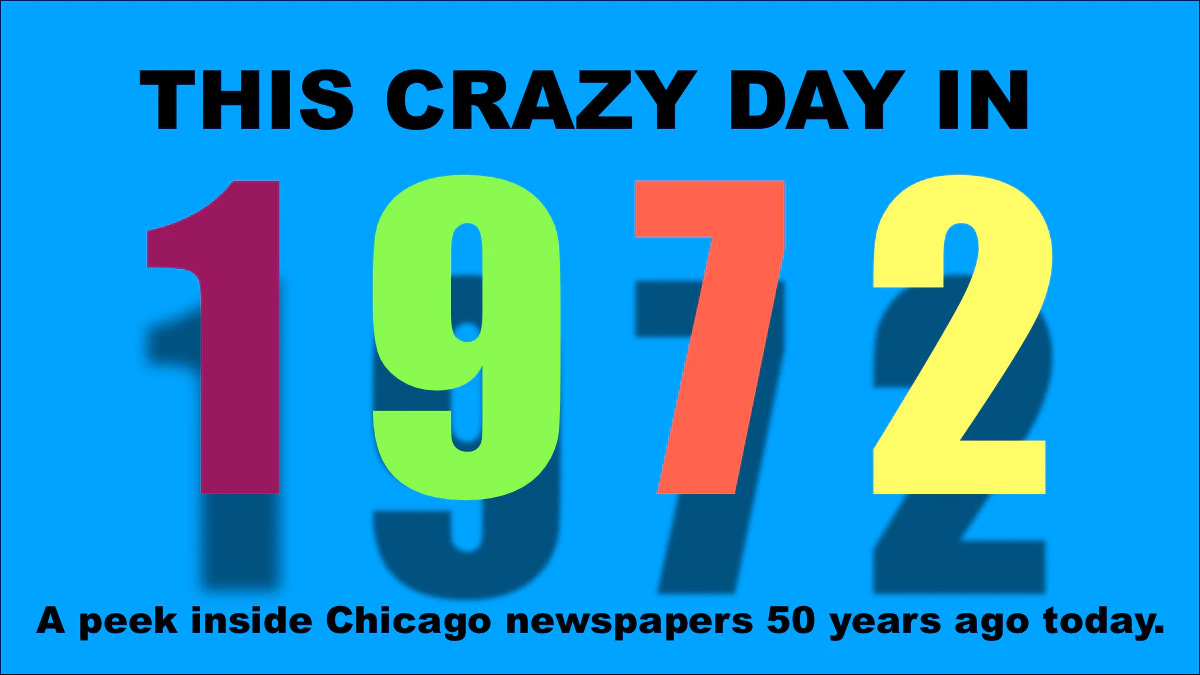

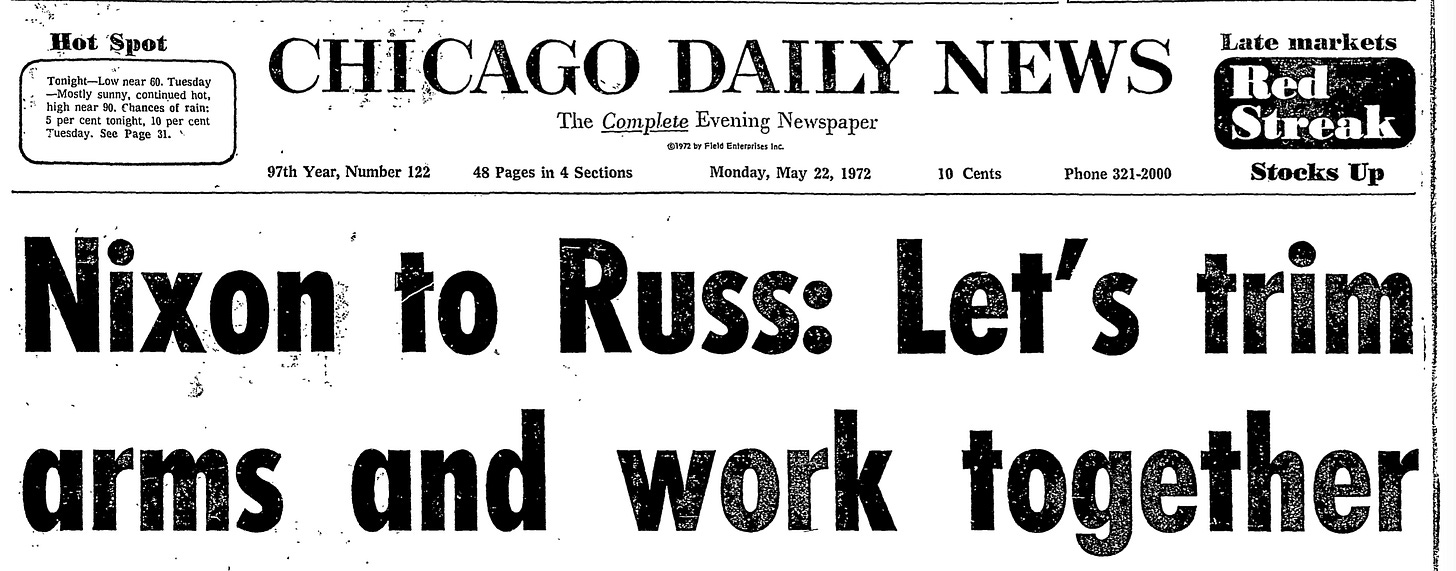


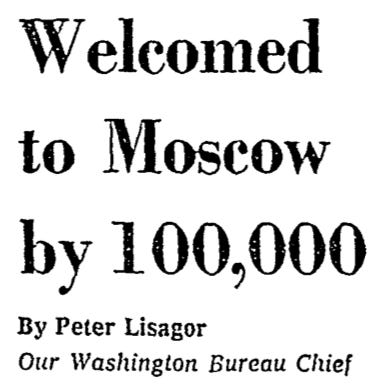



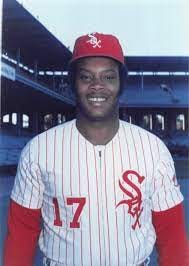

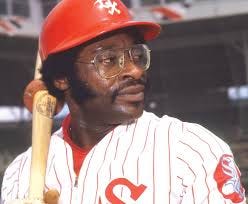


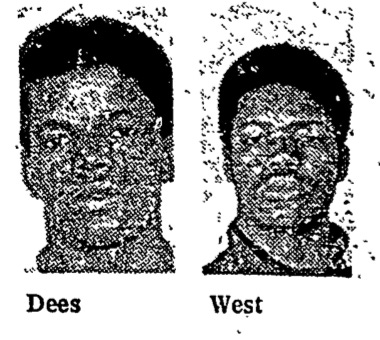






















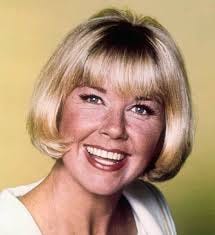
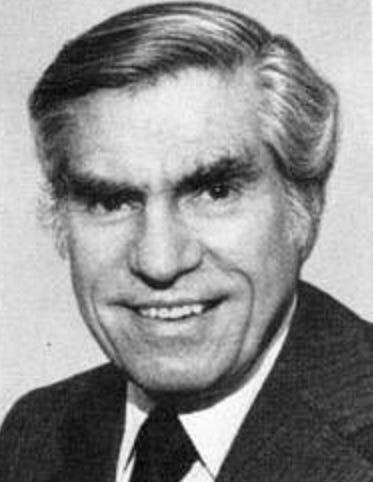


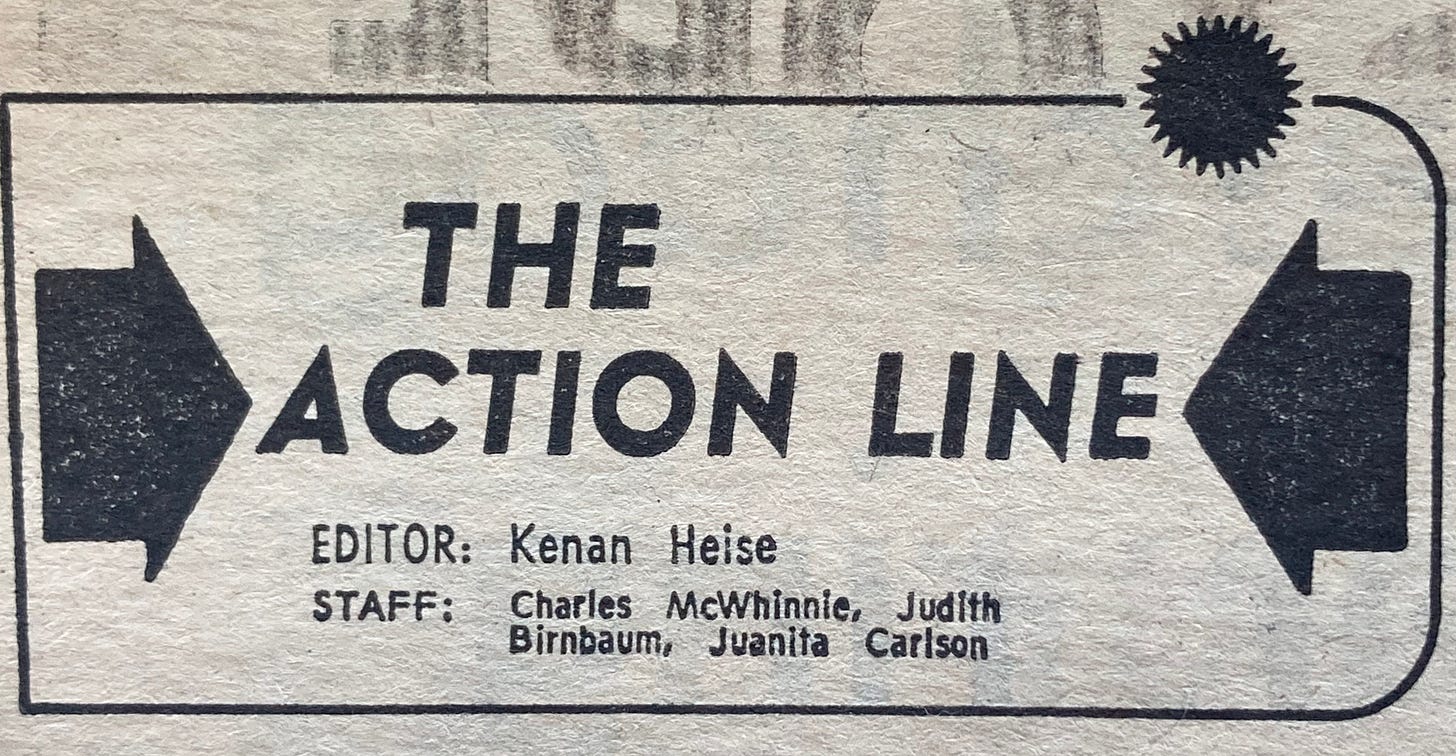







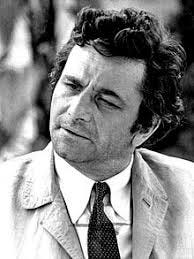










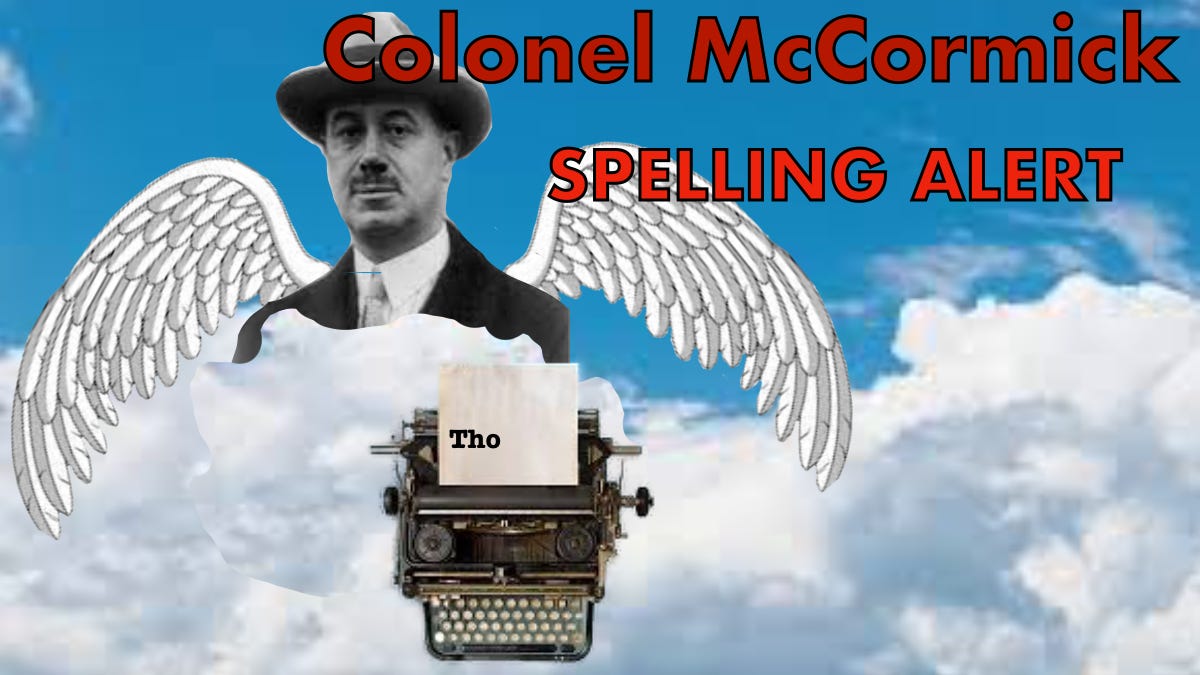

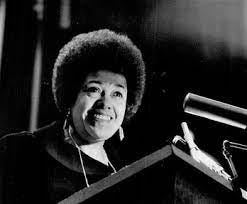


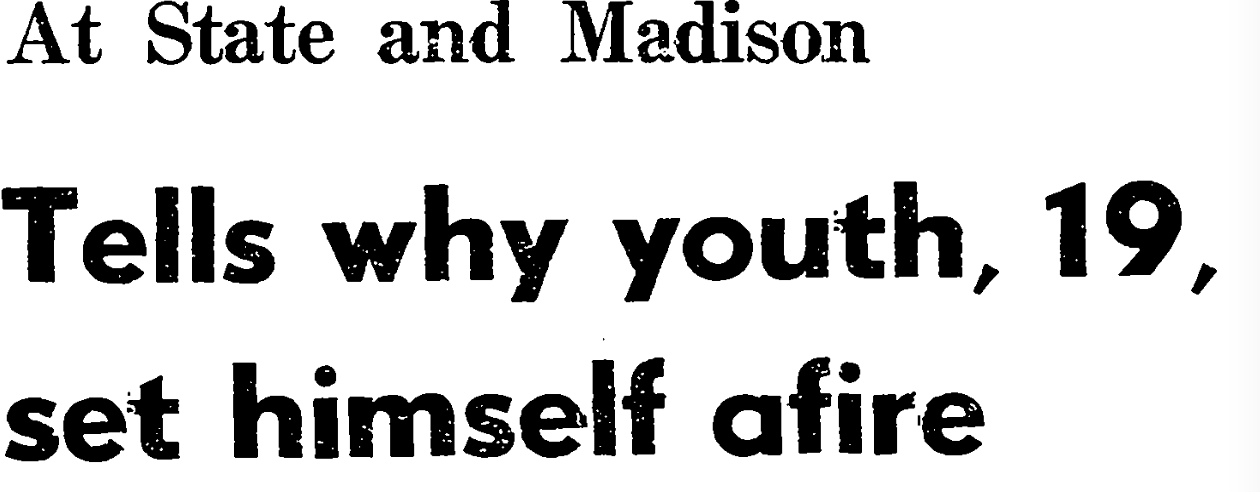
















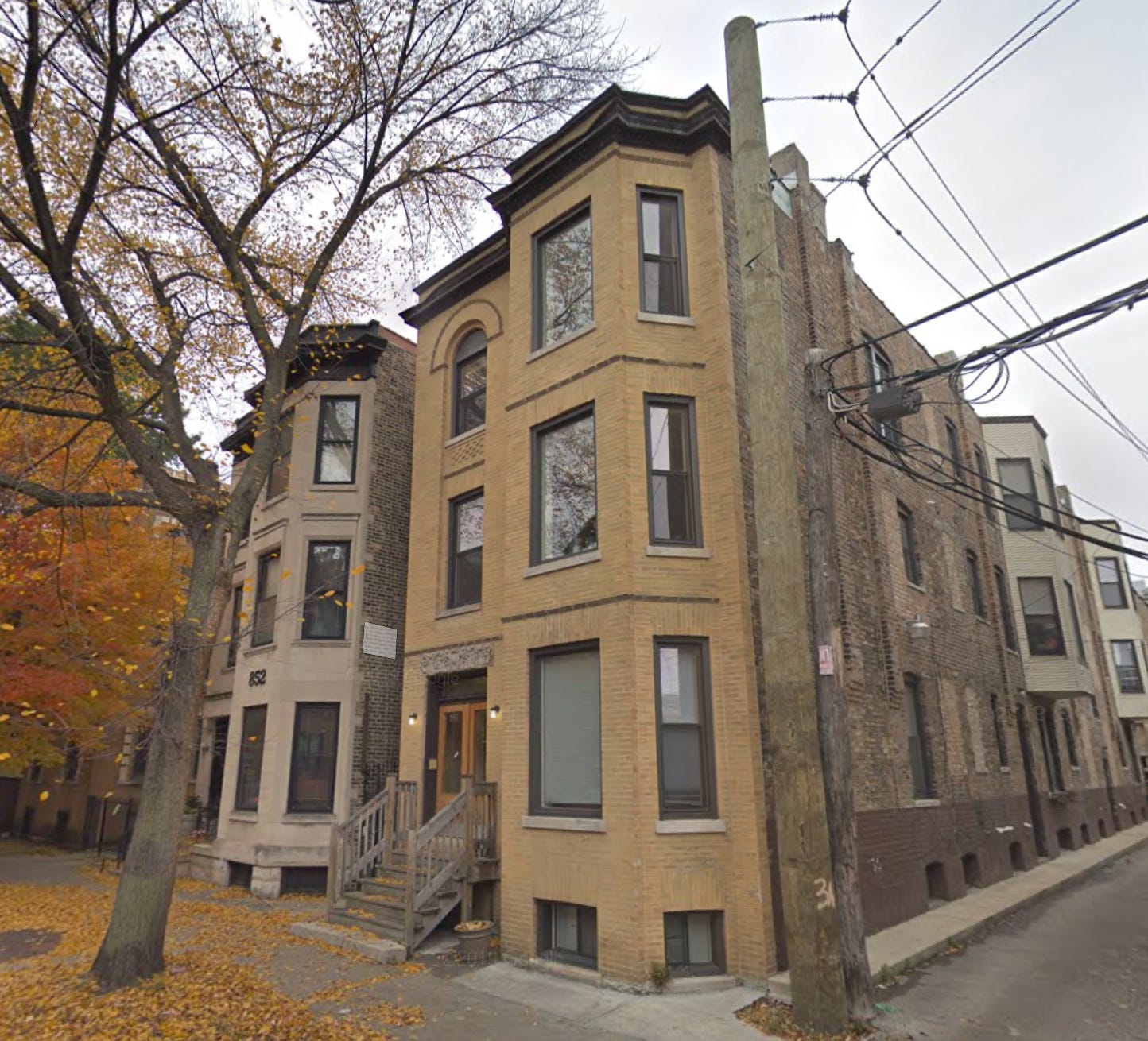






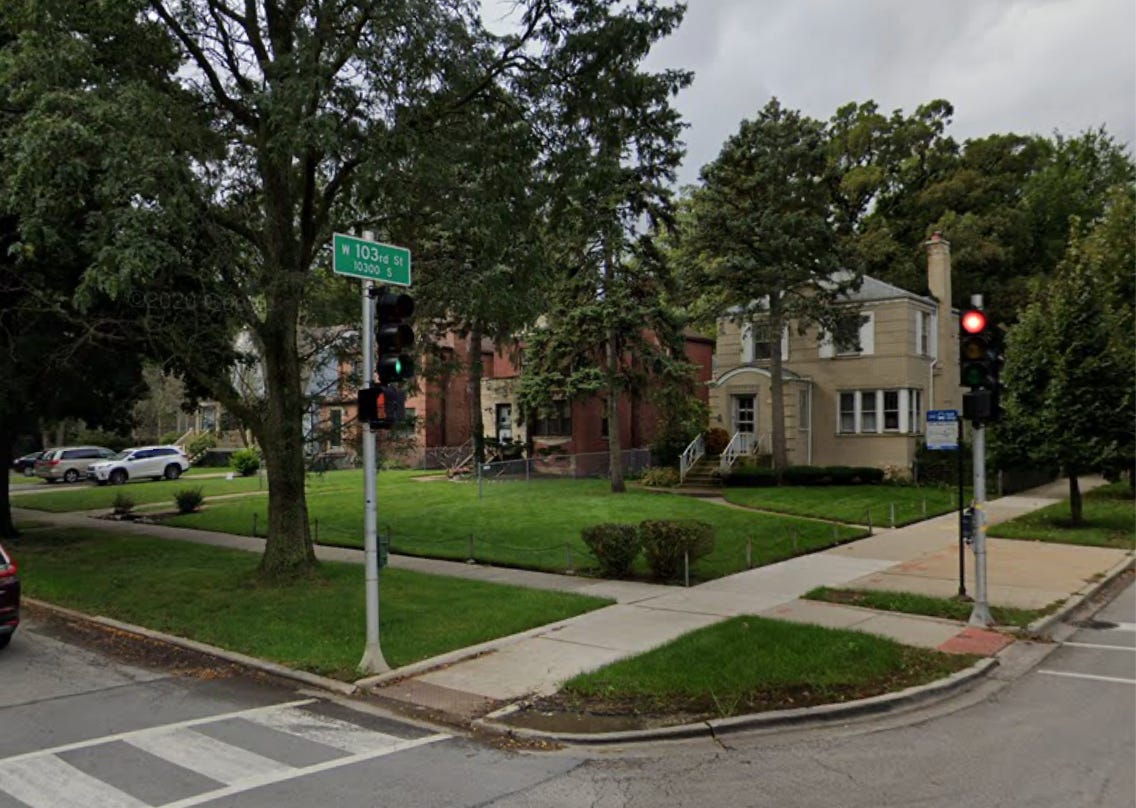











Re the West Pullman attacks, I am interested to see how that will play out in the later chapters. It was around that time that the first black families moved into Riverdale and received a similar reaction. No where near the level of violence that the Jordan's experienced, but it sure wasn't the welcome wagon. White flight in South Cook County was fed by a number of different issues, but irrational and sometimes rational fears played a large role. I know many people that moved from Roseland to Riverdale, Dolton, Calumet City, etc. only to move again in the late 80's and early 90's for the same reason.